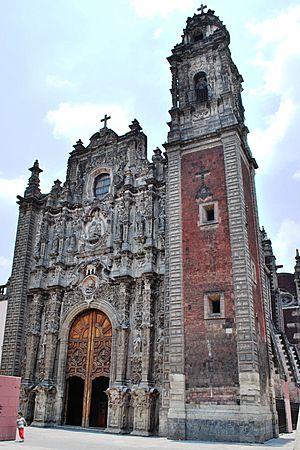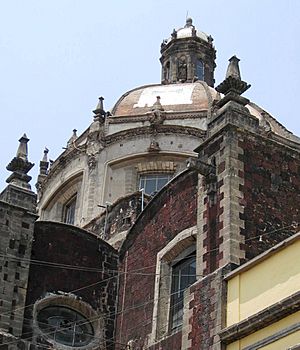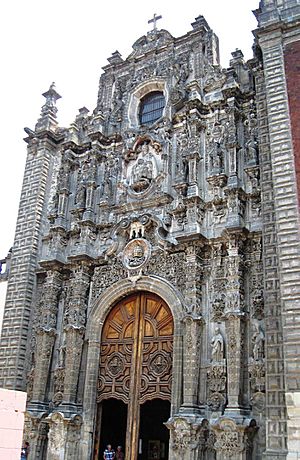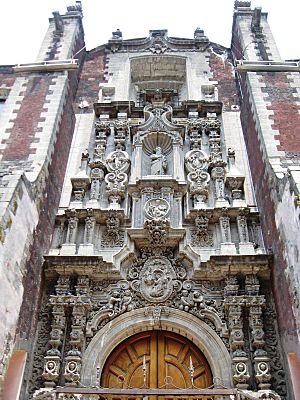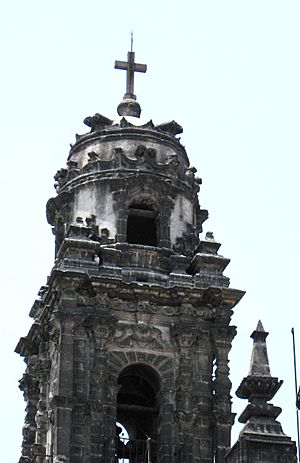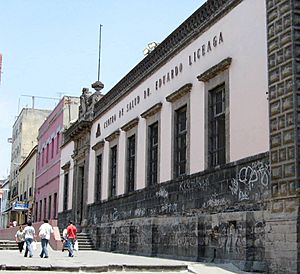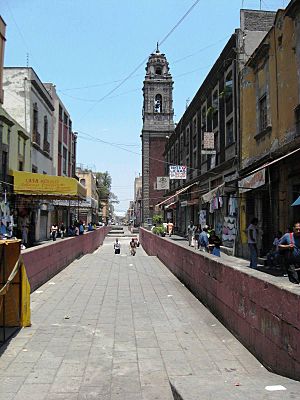La Santísima Church facts for kids
Quick facts for kids La Santísima Church |
|
|---|---|
| Country | Mexico |
| Denomination | Roman Catholic |
| Architecture | |
| Architectural type | Baroque |
La Santísima Church is a historic church in the historic center of Mexico City. You can find it at 12 La Santísima Street, on the corner of Emiliano Zapata Street. Its full name is the Church and Hospital of the Most Holy Trinity (Templo y Antiguo Hospital de la Santisíma Trinidad).
This church was built between 1755 and 1783. It was originally a place of worship for a hospital and hospice that cared for priests. The hospital was used until 1859. At that time, new laws in Mexico, called the Reform Laws, took away much of the Church's property. Today, the church still functions as a place of worship. However, the old hospital and office buildings are now privately owned. Only parts of the original structures are still standing and have been preserved.
Contents
Exploring the Church's Design
The Church Building
The church building has three main sections called naves. The middle section is much wider than the two on the sides. Its architectural style is similar to the Tabernacle of the Mexico City Cathedral. Because of this, many people believe the same architect, Lorenzo Rodriguez, designed both. However, this is still debated. Some features common in Rodriguez's other works are missing here. Also, some records suggest that architect Ildefonso Iniesta Bejarano was involved.
The dome on the outside is decorated with tiles that form Maltese crosses. This symbol belongs to the Trinitarians, a religious group. The church's basic layout is a Latin cross, which was common for churches built in the 17th and 18th centuries. It has a vaulted roof with eight sides that meet at a central point. This central point has windows that let in light. The church is built in the highly decorated Baroque style. However, some areas, like the roof, are quite plain.
The main front of the church looks like older churches nearby. It has a cross layout, detailed relief work, and a window for the choir. But it also includes newer features like "estipite columns." These are special columns that look like upside-down pyramids. The facade also has twelve round carvings, called medallions. Each one shows an apostle.
Between the columns, there are ten sculptures. Five of these show bishops, four show popes, and one shows a priest. Each of these figures is known as a wise scholar of the Church. The main entrance is in the Churrigueresque style. This is a very fancy type of Baroque art. It is made from "chiluca," a hard gray stone, and has two pillars on either side.
The center arch of this entrance has a medallion with the pope's coat-of-arms. Above this, there is a carving that shows the Holy Trinity. God the Father is shown dressed as a pope. The church is dedicated to the Trinity because a group of tailors, who were part of a Trinitarian brotherhood, supported its building.
The side entrance of the church is also in the Churrigueresque style. It has estipite columns. In the middle of this entrance, there is a niche with a statue of Saint Peter. This shows that another group, a brotherhood of clergy dedicated to Saint Peter, also supported the church.
In the arch, you can see an image of Ildephonsus of Toledo. There is also a medallion with a picture of Saint Anthony the Great. He was very popular in Mexico when the church was built. Other medallions show John the Baptist and another saint whose identity is unknown. This side entrance also used to be the entrance to the hospital. Both entrances are richly decorated in the Baroque style. They mostly feature images of apostles, bishops, and scholars, along with angels and cherubs.
On the side of the church facing Emiliano Zapata street, there is a special niche. It is surrounded by small estipite columns. Inside this niche, there is a carving that represents the Corpus Christi. This is a celebration dedicated to the Holy Eucharist. During the time of Spanish rule, this spot was the location of a big festival in the capital city.
The bell tower stands next to the main front of the church. It is topped with a very large sculpture of the papal crown. This crown represents the highest authority of the papacy, or the pope. The tower has estipite columns that were never fully finished. These columns are unique among churches in Mexico City.
Inside the church, very little of the original decoration remains. The church used to have many artworks and altarpieces decorated with gold leaf, but these have disappeared. One thing that is still there is the wooden screen at the main entrance. It blocks light from coming in. This screen is made of cedar and has carved geometric shapes, flowers, and even mermaids. It also has a stained glass window showing the Holy Trinity. Another remaining piece is the choir balustrade. This is also made of cedar and is beautifully carved with baskets of fruit.
The Old Hospital and Offices
Only the main cloister of the hospital building remains today. A cloister is an open courtyard, usually surrounded by covered walkways. Even though it is now private property, it has been restored to keep its historical look. The cloister is rectangular and has two floors with arches on the north, south, and west sides. These arches are supported by thick pillars.
The building has kept almost all of its original walls, both inside and out. However, some parts have been changed to make room for shops and other businesses. Some of the hospital's original courtyard is still visible within the restored building. Only the front of the hospital office building remains. It is located to the north and east of the church. Behind this old facade, there are newer buildings.
A Look at the Church's Past
The story of La Santísima Church began with a small hermitage built in 1526. A tailors' guild (a group of skilled workers) helped pay for it. In 1567, a group of nuns from the Order of Santa Clara moved into the hermitage. They rebuilt the old, decaying building. However, they left the site just ten years later.
The tailors' guild took back the property. They decided to become a more formal religious group, connected to the Trinitarians. Around the same time in 1577, a man named Pedro Gutierrez Pisa started the Brotherhood of Saint Peter. This group wanted to create a hospital and hospice for sick and elderly priests. This group of clergy joined with the Trinitarians to gather money and resources. This led to the creation of the Cofraternity of the Most Holy Trinity (Archicofradía de la Santísima Trinidad). This group had four main goals: to bury the dead, visit the sick, spread Christian teachings, and provide lodging for travelers.
Construction of the first church and hospital began in 1580. However, the church was not officially dedicated until September 19, 1667. By 1735, the original church and its sacristy (a room where priests prepare) were in very bad condition. The archbishop ordered it closed in 1754 so a new church could be built. Construction started the next year, and the new church was dedicated in 1783.
The ground beneath Mexico City is unstable, which has caused serious problems for the church over time. In 1805–06, the church floor was raised to stop flooding during the rainy season. But the problem came back and got worse. This forced the church to close for major repairs from 1855 to 1858. In the 1860s, the building started to lean towards the south. A stone wedge was put in place to prevent it from tilting more. In 1924, experts estimated that the church had sunk 2.85 meters since it was built. The original foundations, which had sunk and were hidden, were dug up in 1980. A public square was recently created here to help stop the church from sinking further.
The church and hospital were closed between 1859 and 1861 because of the Reform Laws. In 1859, the offices were separated from the church, and parts of the property were sold to private owners. A part of the hospital was given to the Lancasteriana Schools. These schools became government-owned in 1890, so this part of the hospital became government offices. By 1936, these offices were sold to private owners. The church was declared a national monument in 1932, along with parts of the remaining hospital building.
See also
 In Spanish: Iglesia de la Santísima (México) para niños
In Spanish: Iglesia de la Santísima (México) para niños
- List of colonial churches in Mexico City


